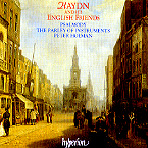A program dedicated to late-18th century English parish church music undoubtedly has a pretty small audience these days–and that’s too bad because in a way very different from the more formal, “professional” concert music of the period, these works have something special to say about the musical life of an ordinary, amateur, yet intensely music-loving part of society. Of course, it doesn’t hurt that Haydn, one of the greatest of all musical geniuses, contributed to this repertoire. During his second visit to London in 1794 he apparently offered his own settings of six psalms–in English–to be included in a new compilation designed to refine and simplify the older versions that had been in use since as early as the 16th century. While you may not come away humming the tunes, you should be impressed by their sturdy elegance and easy, appealing singability. The program also features some pieces, varying in quality and durability, by English “friends and admirers” of Haydn, names mostly obscure–William Shield, John Stafford Smith, William Gardiner, Johan Arnold Dahmen–or known primarily in other contexts–writer/historian Charles Burney. Although the Haydn works are interesting and very well crafted, it’s the work of others that really stands out here. First among several highlights is William Gardiner’s skillful and very effective vocal arrangement of Haydn’s “Emperor’s Hymn” (the famous Adagio from his C major string quartet Op. 76 No. 3), in which he adapts the quartet variations to an ensemble consisting of soprano, alto, tenor, choir, organ, and strings. Perhaps most notable are the three sacred songs of Johan Dahmen, written for vocal soloist (one each for alto, tenor, and soprano) and string quartet. These are exceptional pieces that fully deserve the first rate attention they receive here–especially the Hear my prayer, O Lord, beautifully sung by alto Timothy Kenworthy-Brown, a song that could pass for one of Handel’s best airs.
The playing and singing give full measure to the music, even to the more ordinary works such as Burney’s “dialog hymn” Tell us, O women, or the intriguing yet ultimately tedious 12-minute-long anthem by John Smith, Horrible is the end of th’ unrighteous generation. I really enjoyed Samuel Webbe’s hymnlike Where, Lord, shall I my refuge see?, and the Haydn psalms Blest be the name of Jacob’s God and O let me in th’ accepted hour, this last of such boldness and power that it most certainly could light an inspiring fire under the most intractable congregant. Some of the tracks–the ones that have “congregational singing”–sound saturated, the voices too strong and close. The other tracks are fine. If I had been in charge of programming, I would not have begun the disc with the staid, lengthy Haydn setting of Henry Harington’s rather ordinary tune What art expresses, with its interminable solo opening and rather clunky, plodding fortepiano accompaniment.
































